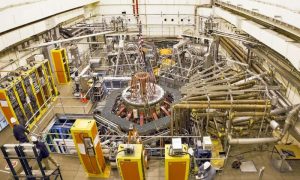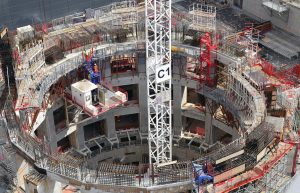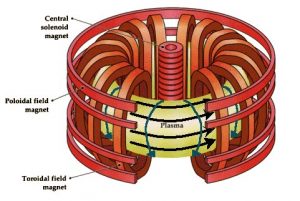When I was young the promise of nuclear energy to transform the world was taken for granted. There were even those who predicted that in just a few years people wouldn’t even have to pay for energy anymore it would be so cheap. Things didn’t quite work out that way.
Nuclear Fission, which produces energy by splitting the biggest of atomic nuclei, uranium and plutonium, produced so much dangerous radioactive material that it soon became very costly, and after a few catastrophic accidents Nuclear Fission was largely, and probably correctly pushed well off to the side.
There’s another kind of nuclear power however, nuclear fusion where the smallest of atoms are forced together to release energy. Fusion actually releases more energy than fission, it is the source of the energy of the Sun and while the fusion process does produce radiation it is much less than in fission and there is none of the nasty leftover radioactive waste that can remain dangerous for hundreds of years.
The problem with fusion is that it is much harder to initiate and sustain a fusion reaction than a fission reaction. For example in an H-bomb the heat and pressure required to trigger the fusion reaction in the first place actually has to be supplied by the fission of an A-bomb. Scientists have been trying for the past 50 years to contain and control a fusion reaction in the labouratory as a precursor to building and fusion power plant. The image below shows an experimental fusion setup at Princeton University’s Plasma Physics Laboratory.

Over the past 5 to 10 years it is European scientists who have taken the lead in this effort with the construction of what it is hoped will be the world’s first fully operational fusion power plant. Named the International Thermonuclear Experimental Reactor (ITER) the plant’s construction in southern France has now reached the halfway point and it is possible that the first plasma ignition could occur by 2025 with full energy production by 2030. The image below shows the ITER reactor building under construction.

The type of fusion reactor that ITER will use to produce its energy is known as a Tokamak design that employs a doughnut shaped ring of electromagnets 300,000 times stronger than Earth’s magnetic field. This powerful magnetic field is needed in order to contain the 150 million degree hot, electrically charged plasma in which the fusion reaction takes place. The image below illustrates how a Tokamak reactor works.

Thirty-six nations are contributing to the $26 billion dollar cost of ITER with the European Union paying about half. Once ITER is completed humanity will have a new star, a second sun of its own creation right here on Earth providing almost limitless clean energy.
Or maybe it could happen sooner. That’s what a team of researchers led by physicist Heinrich Hora of the University of South Wales in Australia hope to demonstrate with a new formula for the fusion reaction.
The Doctor Hora and his team point out that the Tokamak/Plasma style of fusion reactor like that at ITER has two big drawbacks that are the main reason it has taken practical fusion so long to be achieved. First: the fusion reactions in a Tokamak produce large numbers of neutrons, which can escape from the magnetic field carrying a substantial fraction of the energy produced away with them. Second: the energy produced in a Tokamak cannot be directly converted into electricity, it must be used first as heat to generate steam that then drive an electric generator, with a substantial fraction of the energy wasted in each step.
What Doctor Hora and his team suggest instead is a reaction where a single hydrogen atom, really just a single proton, fuses with an isotope of the element Boron, Boron-11. This reaction would produce three nuclei of helium with no escaping neutrons and since the helium nuclei would be ionized the charged particles could then be directly turned into electricity.
The experimental setup the researchers suggest is to have a small sphere of boron-11 in a hydrogen gas. Powerful lasers are then used to literally drive the hydrogen’s protons into the boron nuclei producing fusion and releasing energy.
While no experimental tests of the reaction have been conducted so far Doctor Hora hopes to begin labouratory tests soon. If the reaction proves to be practical a hydrogen-boron reactor could be a simpler and cheaper alternative to achieving practical fusion energy.
